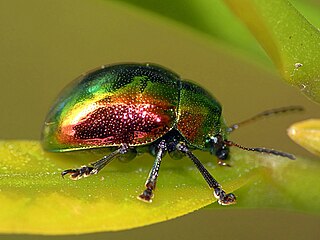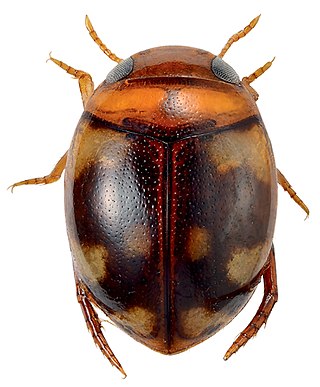
The whirligig beetles are water beetles, comprising the family Gyrinidae that usually swim on the surface of the water if undisturbed, though they swim underwater when threatened. They get their common name from their habit of swimming rapidly in circles when alarmed, and are also notable for their divided eyes which are believed to enable them to see both above and below water. The family includes some 700 extant species worldwide, in 15 genera, plus a few fossil species. Most species are very similar in general appearance, though they vary in size from perhaps 3 mm to 18 mm in length. They tend to be flattened and rounded in cross section, in plain view as seen from above, and in longitudinal section. In fact their shape is a good first approximation to an ellipsoid, with legs and other appendages fitting closely into a streamlined surface. Whirligig beetles belong to the beetle suborder Adephaga, which also includes ground beetles and diving beetles.

Gyrinus natator, the common whirligig beetle, is a species of beetle native to the Palearctic realm, including much of Europe. Its range extends northwards as far as Norway, Finland, and the Saint Petersburg area of Russia. It is an aquatic beetle and moves rapidly around on the surface or swims underwater in still or slow-moving fresh water.
Copelatus taprobanicus is a species of diving beetle endemic to Sri Lanka. It is part of the genus Copelatus in the subfamily Copelatinae of the family Dytiscidae. It was described by Wewalka & Vazirani in 1985.

Gelae is a genus of round fungus beetles belonging to the family Leiodidae. The beetles are found in different parts of Central and North America. They are small and rounded, feeding on slime moulds. They were originally placed in the genus Agathidium following the discovery of the first species, G. cognatum, in 1878. The taxonomic position was revised with description of new species in 2004 by American entomologists Kelly B. Miller and Quentin D. Wheeler. Upon creation of the new genus, the five new species are Gelae baen, G. belae, G. donut, G. fish, and G. rol.

Gyrinus minutus is a species of whirligig beetle in the family Gyrinidae. It is found in North America and Europe.The body is entirely black with a dull appearance due to its microsculpture. G. minutus typically inhabit open edges of larger water bodies like lakes and reservoirs but also reside in sparsely vegetated ponds and slow-flowing river parts. Their swimming abilities are weaker than other gyrinids, and they often disperse in groups when disturbed. Reproduction begins in early spring with mating on water surfaces, followed by egg-laying on aquatic plants. Larvae hatch after a week, growing quickly and reaching maturity within three to four weeks. They are capable of flight, and adults can be found in new locations throughout the summer. G. minutus lacks volatile production for predator defense or has minimal amounts, likely due to its behavior and habitat preferences. Interestingly, while G. minutus rarely aggregates, it can still respond to alarm signals from other species.

Colasposoma sellatum is a species of leaf beetle from Australia and Papua New Guinea, described by Joseph Sugar Baly in 1878. In Australia, it is found around Darwin in the Northern Territory, in the north-east of Queensland and on the Torres Strait Islands. It is the only member of the genus Colasposoma found in Australia, where it is known as a pest of sweet potatoes.

Coelostoma (Coelostoma) vitalisi, is a species of water scavenger beetle found in China, Taiwan, Japan, India, Indonesia, Japan, Malaysia, Nepal, Singapore, Sri Lanka, Cambodia, Thailand and Vietnam.
Pelthydrus suffarcinatus, is a species of water scavenger beetle endemic to Sri Lanka.
Porrorhynchus indicans, is a species of whirligig beetle found in Sri Lanka.
Stenotarsus sicarius, is a species of handsome fungus beetle found in Sri Lanka.
Hydroglyphus flammulatus, is a species of predaceous diving beetle found in India, Sri Lanka, Pakistan, Thailand, Cambodia, China, Taiwan, Korea, Myanmar, Bangladesh, Indonesia, Vietnam, and Nepal.

Cybister tripunctatus, is a species of predaceous diving beetle found in India, Andaman & Nicobar Islands, Sri Lanka, Afghanistan, Bangladesh, Myanmar, Nepal, Pakistan, Bhutan, China, Cyprus, Iran, Iraq, Japan, Kyrgyzstan, Mongolia, Russia, Syria, Tajikistan, Turkmenistan, Italy, Turkey, Uzbekistan and Europe.

Microdytes maculatus, is a species of predaceous diving beetle found in India, Thailand, Southern Andaman Islands, Sri Lanka, China, Thailand, Laos and Myanmar.
Arixyleborus malayensis, is a species of weevil found in India, Sri Lanka, China, Japan, Malaysia, Vietnam and Indonesia. This is the only species of Arixyleborus found in Japan and China.
Arixyleborus mediosectus, is a species of weevil found in India, Sri Lanka, Cambodia, Myanmar, Philippines, Malaysia, Indonesia: Sumatra and Vietnam.
Arixyleborus rugosipes, is a species of weevil native to India, Sri Lanka, Philippines, Malaysia, Borneo, Vietnam, Indonesia, and in Australia, Japan, Korea, New Zealand as an exotic species.
Megalocaria dilatata, is a species of lady beetle native to India, Sri Lanka and Bhutan.
Acalyptomerus asiaticus, is a species of fringe-winged beetle found in India, Sri Lanka, Malaysia and Thailand. It is also introduced to Jamaica.
Clambus ceylonicus, is a species of fringe-winged beetle endemic to Sri Lanka.
Aspidimorpha dorsata, is a species of leaf beetle widely distributed in South Asia and South East Asia.








